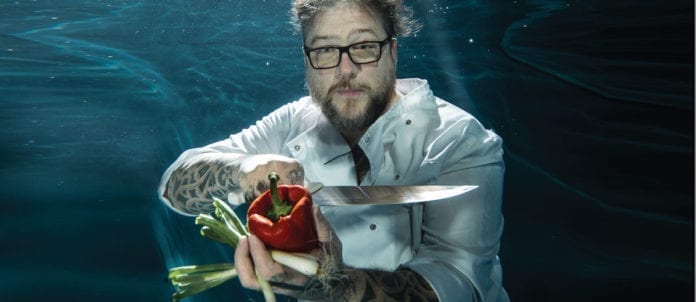Ask any chef about their choice of knives and most will tell you it’s a personal subject. There are those strictly interested in the utilitarian features and functions at an affordable price. Others are avid collectors and money is no object when considering the aesthetics of a beautifully crafted handle or meticulously engraved blade.
There are countless factors that drive a chef’s decisions, including the types of cuisine they favour, the task at hand (butchering meat, scaling fish, chopping vegetables, et cetera), the weight and balance of the handle, the bevelling and shape of the blade and the hardness of the steel.
A growing number of chefs are favouring Japanese blades for their knife-wielding chores, citing the fact they’re lighter, sharper and, for some, more pleasing to the eye. Others tend to stick to tried-and-true European blades for jobs that require a heavier hand.
GOING WHOLE HOG
In Calgary, Charbar’s Jessica Pelland is a chef who actually prefers a heavier style of knife. “I absolutely appreciate the craftsmanship and quality of steel in Japanese knives, but they’re just too dainty for me.”
That’s because chef Pelland does her own hunting and whole-animal butchery. “More delicate knives are just not conducive to scraping against bone. Although I do have to say, one of my favourite pieces is a Japanese hatchet. It’s amazing for chopping through smaller bones and joints. I’m not a huge person, so I find cleavers hard to wield. The hatchet is more graceful and precise for me.”
One of her other favourites is an Equinox curved pastry knife made by New York-based Equinox International. “It’s an amazing utility knife for bread, carving and vegetable prep,” she says.
Her toolkit also includes two boning knives — one stiff and one flexible — along with a curved and serrated Victorinox knife and a Wüsthof paring and 12-inch chef knife. “When I’m breaking down a whole animal, the Victorinox Scimitar is great for dealing with the hind quarters and big muscles. I also have a Victorinox skinning knife for cleaning fat and skin.”
Rather than a stone, she uses rods for maintaining the blades, including a coarser-grit steel or diamond rod for sharpening and a smooth steel or ceramic rod for honing. Pelland says, when it comes to knives, she’s purely pragmatic. “I’m definitely of the practical set. There isn’t a knife I own that I don’t use within a month.”
As MacLean notes, knives are professional tools like any other trade. “If you work at home and don’t do construction, then Canadian Tire tools are fine. If you work in construction, you have customized high-end tools. It all depends on the job.”
FISHING FOR FINESSE
As a chef whose repertoire is mainly fresh seafood, Shane Robilliard, executive chef/ Food and Beverage director at the Fox Harb’r Resort in Wallace, N.S., says his work definitely requires knives that are sharp and thin. “Nothing is more important than that. Seafood is so delicate compared to a big porterhouse steak. You have to attack it completely differently. Japanese knives have a much longer edge that holds much longer. European knives, for their part, don’t have quite the give and angle.”
One of his must-have tools is a Shun fillet knife. “It’s very flexible and great for finer work like tuna tartare or carpaccio,” he explains. When working on heavier chores, such as breaking down a 120lb. halibut, he uses a 10-inch Mercer fillet knife.
In Robilliard’s experience, the handle is almost as important as the blade itself. “You have to know how the handle will feel when you are holding the knife,” he says.
As for honing them, he works with whetstones, using a combination of a 1,000 and 5,000 grit. “The Japanese knife requires a different angle when sharpening, so you have to do it differently. It just takes a few minutes, but it pays dividends over the long term.”
SLICING IT RIGHT
Ryan Gatner, owner of When the Pig Came Home Delicatessen in Toronto, is always on the lookout for knives to add to his collection. “I have some beautiful pieces that I don’t even use. I have a rare eight-inch Kato Gyuto knife with crazy white powder-coated steel that I bought at Tosho Knife Arts. I spent $1,000 and don’t even use it.”
A butcher by training, Gatner says he originally worked with German knives. Now, most of the knives he uses for daily butchering and slicing work at the deli are Japanese, including two Fuji slicing knives and one Gyuto all-purpose chef’s knife. His favourite is a blue-steel Honesuki chicken-boning knife. “The tip and the way it’s angled in the heel is incredible. It can slice through chickens so fast and the edge retention is insanely good.”
He also has a Henckels chef’s knife and bread knife for basic chores. When choosing a knife for slicing, he says the biggest factors are edge retention and sharpness. “The width of the knife and how it feels is also very important. The handle has to be comfortable. When you’re chopping all day, using a lighter knife can make a big difference on the wrist.”
The bevelling of the blade is also important, depending on the function, he adds. “A 50/50 is the easiest to sharpen. Some come with a 60/40 or 80/20 bevel, but they’re more sushi-grade knives.”
THE DELICATE BALANCE OF SUSHI
As the owner of Calgary-based Shokunin — one of Canada’s top-ranked Japanese-style brasseries — chef Darren MacLean has a deep-hearted respect of the art and utility of Japanese knives. Among other achievements in his career, MacLean was the only Canadian chef to be chosen to appear in the new Netflix global cooking-competition series The Final Table.
“When I started to get into the Japanese-knife world, I loved the degree of specialty,” he says. “There’s really no such thing as an all-purpose knife. They’re very specialized for what they do and incredible to work with, because the steel and craftsmanship are so superior.”
His Deba knife, for example, is ideal for delicate fish work, he says. MacLean also uses a Honesuki for butchering chicken and a Yanagiba single-bevelled knife for slicing fish for sushi and sashimi, which he describes as being “literally designed for consistency.”
His Sujihiki double-bevelled knife is the perfect tool for cutting scales off fish without removing the skin. Another essential in his repertoire is his Santoku, which he uses for chopping vegetables.
Because he has larger hands, MacLean says he prefers a western-style handle for many of the knives. But, for sushi, he prefers the traditional round handle because it’s lighter.
An added incentive is that every knife has a personality and carries the signature of the person who made it. “My knives are very clean and precise. That reflects who I am as a chef. The number-1 [consideration] besides the craftsmanship when choosing a knife is that I can express what I am as a chef.”
Written by Denise Deveau


















